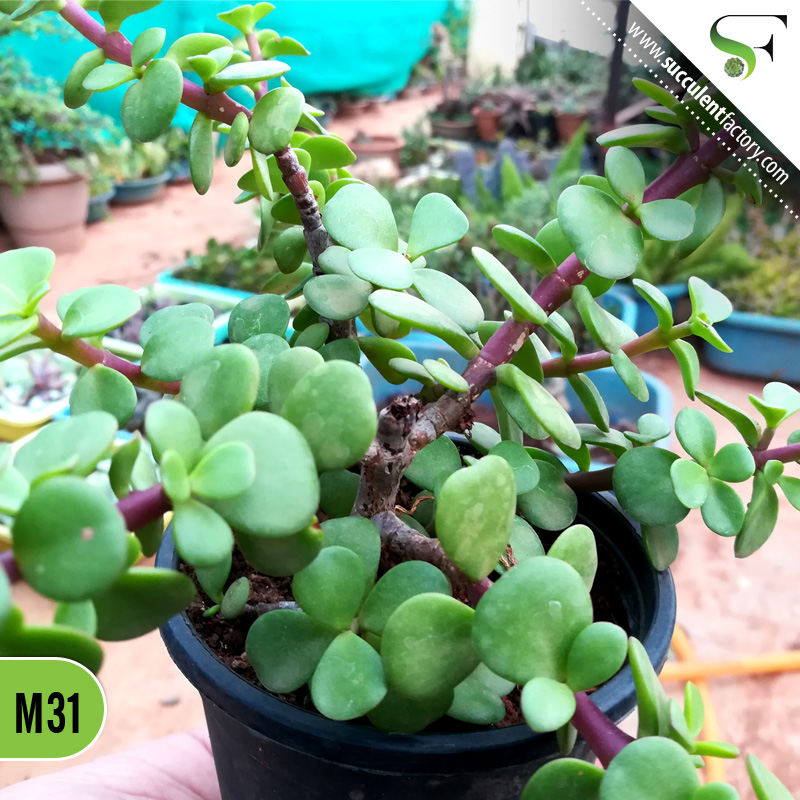Elephant Bush Jade
Original price was: ₹99.00.₹29.00Current price is: ₹29.00.
The Elephant Bush Jade, scientifically known as Portulacaria afra, is a resilient and visually appealing succulent native to South Africa. It’s often referred to as “Elephant Bush” due to its thick, gnarled stems and the fact that elephants in its native habitat are known to graze on its leaves. This versatile plant is prized for its attractive foliage, which ranges from green to reddish-brown, and its ability to thrive in various conditions, making it an excellent choice for both indoor and outdoor cultivation.
ALL THE PLANTS WILL BE SENT BARE ROOTED. NO SOIL NO POT
Description
The Elephant Bush Jade, scientifically known as Portulacaria afra, is a resilient and visually appealing succulent native to South Africa. It’s often referred to as “Elephant Bush” due to its thick, gnarled stems and the fact that elephants in its native habitat are known to graze on its leaves. This versatile plant is prized for its attractive foliage, which ranges from green to reddish-brown, and its ability to thrive in various conditions, making it an excellent choice for both indoor and outdoor cultivation.
Tips to Growing Elephant Bush Jade:
- Light: Provide bright, indirect sunlight for your Elephant Bush Jade. It thrives in full sun but can also tolerate partial shade. Indoors, place it near a sunny window where it can receive ample sunlight throughout the day.
- Soil: Use a well-draining soil mix formulated for succulents and cacti. A blend of potting soil, perlite, and coarse sand works well to prevent waterlogging and promote healthy root growth.
- Watering: Elephant Bush Jade is drought-tolerant and prefers infrequent but deep waterings. Allow the soil to dry out between waterings, then water thoroughly until excess water drains from the bottom of the pot. Reduce watering during the winter months or when the plant is in dormancy.
- Temperature: This succulent prefers warm temperatures and can tolerate a wide range, but it’s sensitive to frost. Protect it from freezing temperatures, and bring it indoors if the weather becomes too cold.
- Humidity: Elephant Bush Jade thrives in low to moderate humidity levels. It’s well-suited to indoor environments but benefits from adequate airflow to prevent fungal issues.
- Container: Choose a container with drainage holes to prevent water from pooling around the roots. Terra cotta pots are excellent choices as they allow for better airflow and water evaporation.
- Propagation: Elephant Bush Jade is easy to propagate from stem cuttings. Simply snip a healthy stem, allow it to callus for a few days, then plant it in a well-draining soil mix. Keep the soil lightly moist until roots develop.
- Pruning: Regularly prune your Elephant Bush Jade to maintain its shape and encourage bushier growth. Remove any dead or leggy stems, and pinch back growing tips to promote branching.
- Fertilization: Feed your Elephant Bush Jade with a balanced, diluted fertilizer during the growing season (spring and summer). Avoid fertilizing during the winter months or when the plant is dormant.
- Pests and Diseases: Keep an eye out for common succulent pests like mealybugs and spider mites. If detected, treat them promptly with insecticidal soap or neem oil. Avoid overwatering to prevent root rot and fungal diseases.
With proper care and attention to these tips, you can enjoy growing and caring for your Elephant Bush Jade, adding a touch of natural beauty to your indoor or outdoor space.





Reviews
There are no reviews yet.